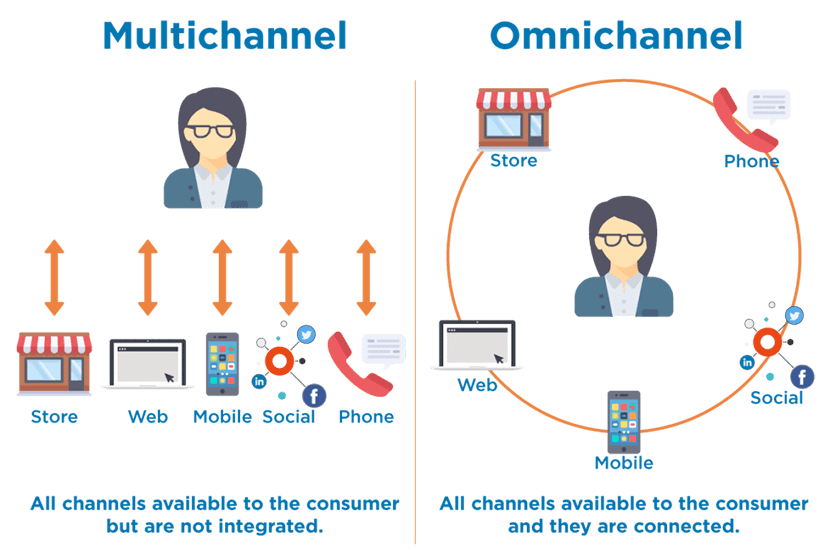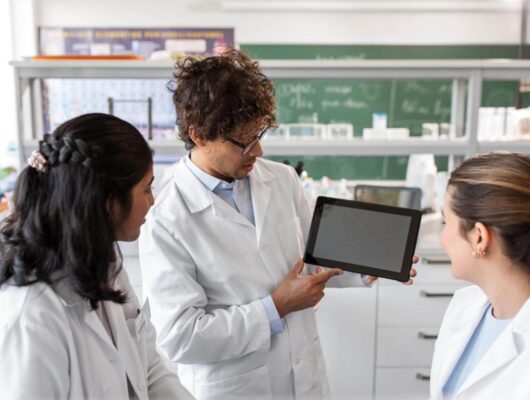Omnichannel Marketing Strategy For Life Science Companies
When facing intense competition, personalization and customer experience are key differentiators not only for life sciences and biotech brands, but for any company looking to keep up with digital transformation trends. With that in mind, in 2022, a successful digital transformation of any brand involves having a well-orchestrated omnichannel strategy, regardless of its current level of marketing maturity.
The COVID-19 pandemic has created a huge level of uncertainty, and massive disruptions throughout all industries. In the resulting socio-economic climate centered around social distancing and shelter-in-place, the use of digital channels and analytics when mapping out a marketing strategy has become a common practice.
An omnichannel marketing definition describes an online experience which has the power to engage customers across multiple touchpoints, in an orchestrated and seamless way. With a results-based approach, the goal of this type of marketing strategy is to provide a personalized, coordinated, and consistent experience for both brands and customers, across all channels.
When it comes to the life sciences and biotech industries, the transition towards an omnichannel experience has started much later, and was significantly slower compared to other industries. But although more rigid when it comes to change, most pharma companies have come to recognize the value omnichannel marketing brings, and are starting to adapt to it.
Whether you are a business owner or a marketer in the life science field, adapting to a new way of thinking, and building customers’ journeys that are engaging and easy, is the key towards a successful marketing approach in 2022.

Image Courtesy: Bite Sized Knowledge
What Is The Difference Between Omnichannel & Multichannel Marketing?
When it comes to marketing, the terms omnichannel and multichannel can be confusing, with many believing that they are one and the same thing. But although both of them involve selling across multiple digital and physical channels, there’s a key difference in how each one maps out the user’s experience.
Multichannel marketing is unidirectional, and doesn’t take into consideration the customer’s needs. With all marketing channels being separate and independent from the other, a multichannel approach pushes content towards the customer without any prior knowledge of its interests, needs or timing preferences. Without a strategy to unite the customer experience across various channels, multichannel marketing works in a vacuum with its own strategy and goals, and creates a confusing and an impersonal experience that often leads to missed opportunities.
The multichannel experience is what most businesses invest in today. They have a website, blog, and social media pages like Facebook, and Twitter. They use each of these platforms to engage and connect with customers. However, in most cases, the customer still lacks a seamless experience and consistent messaging across each of these channels.
An omnichannel experience, on the other hand, puts the customer in the center, and accounts for each platform and device customers will use to interact with the company. That knowledge is then used to deliver them an integrated experience. Companies using this technique align their messaging, goals, objectives, and design across each channel and device. By aligning these factors together, brands can use these related channels to enhance their marketing and service efforts. Omnichannel marketing is a valuable asset for businesses that are looking to deliver a seamless experience and customer lifetime value.
For life sciences, implementing an omnichannel marketing strategy allows them to deliver a consistent, personalized experience for both physicians and patients, across different channels. This superior customer journey that accounts for all customer interactions possible helps communication flow seamlessly across both desktop and mobile devices, and provides a consistent engagement no matter where or how the customer is interacting with their brand.

How Do You Build An Omnichannel Marketing Strategy That Impacts Customer Experience
In 2022, life science and biotech brands that are unable to pull data from diverse online sources to create a seamless, hyper personal, buyer journey, are bound to be left behind by their competitors. You can have amazing mobile marketing, engaging social media campaigns, and a well-designed website. But if they don’t work together, it’s not omnichannel.
So whether you’re a big pharma organization looking to address healthcare practitioners, or a startup focused on research and development, an omnichannel approach is likely to provide the return. If you don’t know where to start, in the following part of our article we’ll go over how to develop and maintain an omnichannel marketing campaign.
1. Who Are Your Customers?
The success of life sciences’ omnichannel marketing campaigns is dependent on a genuine understanding of their customers, both patients and physicians.
Knowing your customers is the first step to offering them good service. Other than that, paying greater attention to your audiences and engaging with them directly, can lead to improved adherence, better patient overall health and increased brand impressions. In fact, we can safely say that when it comes to creating an effective marketing strategy, half the battle is won when you know, at a deep level, each and every interaction your user has with your brand, across both web and mobile. However, marketers must be warned that understanding the customers’ psyche is not easy and most often requires a thoughtful analysis to anticipate their needs, and exceed their expectations.
2. Develop a Google Dashboard And Map Out The Client’s Journey
When setting up your omnichannel marketing strategy, a customer journey map creates a visual representation of the process a customer goes through to achieve a goal with your company. With the help of an individual’s journey map, you can get a better sense of their needs, pain points and motivations, and offer a better customer service. To create an experience that is truly customer-centric, marketers need to map the patient’s holistic journey by providing meaningful engagement points, invite customer feedback, build segmentation models, delve into patient journeys, and observe brand touchpoint interactions.
3. Think About The Content
Taking an omnichannel approach to digital marketing ensures life science and biotech companies that every piece of content produced, published and promoted is part of a wider strategy. Consistency of messaging across all of the channels is essential for businesses, especially if a brand is keen to make the buying journey as effective as possible. By having a consistent tone, style and strategy you ensure your message is clear and keeps consumers engaged every time they connect with your brand.
But how much content exactly is it needed for an ultimate omnichannel strategy?
The short answer is that life sciences brands don’t need to make a lot of content. What they do need to create though, is something that is both valuable and engaging, combined with good storytelling and emotional adequacy. Interactive ebooks and scientific animation videos help brands explain their science to customers that do not have enough specific knowledge to understand their products and services, or the mechanism of action of a drug. Interactive content is also great for customers with a short attention span, who don’t have the time or patience to read through websites or lengthy PowerPoint presentations.
4. Omnichannel Analytics
Once you have successfully developed a comprehensive omnichannel marketing vision, you will need to monitor your progress and check if your strategy is working. When it comes to customer data insights, the information can be overwhelming so you need to keep it simple. Find your top KPIs to track, make it visual so everyone on the team, including yourself, can gain insights –quickly and accurately – on next steps. Data about your customers’ history with your brand, the total amount of time spent on your website, and the frequency of visits can help you look at your users as individuals not just numbers on a spreadsheet. Other than that, omnichannel analytics offers up-to-date metrics, data, and insights regarding:
- Channel usage
- Message impact by channel
- Customer Coverage
- increase in sales over time.
- Customer satisfaction
- Brand awareness
- Customer retention
- Conversion rates
5. Artificial Intelligence
Today, as the life sciences industry recognizes that artificial intelligence’s impact on their commercial operations is here for good, expert systems have expanded to all channels and tasks in the commercial process. A.I. has the capability to analyze and optimize the performance of each one of these channels, especially the way they relate with one another.

6. Take Control Of All Digital Channels
Marketing Email: Email marketing holds an important position in an omnichannel marketing approach as it can unravel your customer’s digital life, and can drive the highest ROI among other digital communication channels.
Self-Service (web): As research shows, customers now rely more on self-service than they do on phone. And although the phone is still a popular method of support, customers are going to the web more and more as a first resource to solve their issues.
Compliant Social Bots: One of the biggest trends in terms of customer support for 2022 are bots. With more and more life science and biotech companies using them to help customers find information, to route queries to the right department, and to carry out transactions that don’t require a human agent, Bots are picking up traction in 2021. Bots can also help bridge the gap between the best channel and the channel that customers choose by themselves.
Webinars: Webinars should be part of all life sciences’ omnichannel marketing strategies. A Webinar gives companies the chance to create and deliver high-quality visual content that can have a positive impact on their audience, while offering them the chance to take questions from their audience and answer them.
7. Manage Personal Touch Points
Face-to-Face Contact: Face-to-face communication enables physicians to establish personal contact with the drug company, and learn new drug information, receive drug samples, or connect with peers through sales representatives.
Remote Detailing: Remote detailing or electronic detailing, is by now a well-established way of increasing pharmaceutical and medtech company efficiency in customer engagement, enabling a better service to be delivered to healthcare professionals or other stakeholders.
Virtual Meetings: Virtual meetings are an effective low-cost strategy for conveying information to scientists who otherwise would be deprived of the opportunity. Unlike conventional conferences, virtual conferencing permits the involvement of a greater number of participants that would be unable to participate now due to COVID-19 restrictions, insufficient funds or travel restrictions.
Contact Centers: The healthcare contact center has been impacted by COVID-19 with not a one-size-fits-all solution at the moment. Throughout their omnichannel marketing efforts, some organizations will shift to a hybrid remote agent model, with staggered in-office shifts to ensure distancing while others will embrace a fully remote environment. Within the highly regulated and competitive life sciences industry, contact centers must meet strict compliance standards while simultaneously providing an efficient and personalized customer experience.

Transitioning Towards Omnichannel Marketing & Analytics With Sciencia Consulting
What is your level of company’s omnichannel marketing and analytics readiness?
No matter what stage you might find yourself in, our marketing experts can help you achieve a smooth transition to an omnichannel approach, while also offering you tips and advice on biotech branding and marketing, or life science new product launch.
If you have any question regarding digital marketing for life sciences feel free to drop us a line or request a free consultation. In the meantime, take a look at some of our other blog articles:







